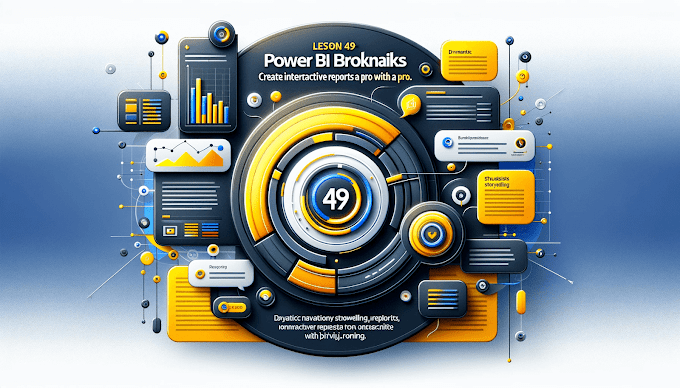Welcome back to Virvijay.com, where we simplify Power BI for you!
As datasets grow, Power BI reports slow down due to inefficient data models, heavy DAX calculations, and poor visualization practices. A slow dashboard frustrates users and affects decision-making.
In this blog, you'll learn:
- Why Power BI reports slow down
- Best practices to improve performance
- How to optimize DAX queries
- How to reduce report load time
By the end, your reports will be faster, smoother, and more efficient! 🚀
1️⃣ Why Do Power BI Reports Become Slow?
Common reasons for slow Power BI reports:
- ⚠️ Large datasets with too many rows and columns
- ⚠️ Unoptimized DAX formulas that consume excessive memory
- ⚠️ Poor data model design (wrong relationships, too many calculated columns)
- ⚠️ Complex visuals with unnecessary calculations
- ⚠️ Too many measures increasing processing time
Let's fix these issues one by one! 🛠️
2️⃣ Best Practices for Optimizing Power BI Performance
✅ A. Reduce Data Model Size
🔹 Remove Unused Columns & Tables
- If a column is not used in reports, remove it from the dataset.
- Use Power Query to filter unnecessary data before loading it into Power BI.
🔹 Use Proper Data Types
- Avoid Text Data Types when possible. Convert them to Integer or DateTime.
- Smaller data types (e.g., Integer instead of Decimal) save memory.
🔹 Aggregate Data Before Importing
- Instead of loading all raw transactions, load summarized data.
- Example: Instead of loading 1 million rows, group data by month or product category.
📌 Before: 10 million daily sales records
📌 After: Aggregated sales by month & product → only 10,000 rows
Result: Faster data load & better performance! 🚀
✅ B. Optimize Relationships & Data Modeling
🔹 Use Star Schema Instead of Snowflake Schema
- Keep fact tables (sales, transactions) separate from dimension tables (products, customers).
- Avoid chained relationships that slow down performance.
📌 Best Practice:
✅ Fact Table: Sales Data (TransactionID, Date, ProductID, Amount)
✅ Dimension Table: Products (ProductID, Product Name, Category)
🔹 Avoid Many-to-Many Relationships
- Use bridge tables instead of direct many-to-many joins.
✅ C. Improve DAX Performance
Unoptimized DAX slows down reports. Here’s how to fix it:
🔹 1. Use Variables (VAR) Instead of Repeating Calculations
Bad Practice ❌
DAX
Total Profit = SUM(Sales[Revenue]) - SUM(Sales[Cost])
Better Approach ✅
DAX
VAR TotalRevenue = SUM(Sales[Revenue])
VAR TotalCost = SUM(Sales[Cost])
RETURN TotalRevenue - TotalCost
Why? Using VAR stores values once instead of recalculating them multiple times.
🔹 2. Use SUMX Instead of SUM for Row-by-Row Calculations
Bad Practice ❌
DAX
Total Revenue = SUM(Sales[Quantity] * Sales[Price])
Better Approach ✅
DAX
Total Revenue = SUMX(Sales, Sales[Quantity] * Sales[Price])
Why? SUMX iterates row by row, ensuring better accuracy & performance.
🔹 3. Use Aggregations Instead of Calculated Columns
Bad Practice ❌ (Calculated Column)
DAX
Sales[TotalAmount] = Sales[Quantity] * Sales[Price]
Better Approach ✅ (Measure)
DAX
Total Sales = SUMX(Sales, Sales[Quantity] * Sales[Price])
Why? Calculated columns increase data model size. Measures are faster & lightweight.
🔹 4. Use FILTER Sparingly
Bad Practice ❌
DAX
Filtered Sales = CALCULATE(SUM(Sales[Amount]), FILTER(Sales, Sales[Region] = "North"))
Better Approach ✅
DAX
Filtered Sales = CALCULATE(SUM(Sales[Amount]), Sales[Region] = "North")
Why? FILTER(Sales, ...) scans the entire table. Direct filtering is faster.
✅ D. Optimize Visuals & Report Design
🔹 Limit the Number of Visuals on a Page
- Each visual adds load time. Keep only necessary visuals.
- Instead of multiple visuals, use bookmarks & drill-through pages.
🔹 Use Pre-Aggregated Tables for Large Datasets
- If a table has millions of rows, create a summary table for faster queries.
🔹 Reduce Number of Measures in a Single Report
- Too many measures increase memory usage.
- Use shared measures instead of creating multiple similar measures.
3️⃣ Power BI Performance Tuning Checklist ✅
- ✅ Remove unnecessary columns & tables
- ✅ Use correct data types (avoid text where possible)
- ✅ Use aggregations instead of raw data
- ✅ Optimize relationships (avoid many-to-many joins)
- ✅ Write efficient DAX using VAR, SUMX & optimized filters
- ✅ Reduce number of visuals in reports
- ✅ Use summarized tables for large datasets
4️⃣ Bonus: Power BI Performance Analyzer Tool
🔹 Power BI has a built-in "Performance Analyzer" tool
- Go to View → Performance Analyzer
- Click "Start Recording" and interact with your report
- It shows which visuals & DAX queries are slow
- Use this insight to optimize slow queries
📌 Pro Tip: If a report is slow, check which visual or measure takes the most time and optimize it!
What’s Next?
Now that you’ve learned Power BI performance tuning, let’s move to Power BI Security & Row-Level Security (RLS).
📌 In the next blog, we’ll cover:
- ✅ How to restrict data access using Row-Level Security (RLS)
- ✅ How to implement security roles in Power BI
- ✅ Best practices for securing Power BI reports
Stay tuned to Virvijay.com for more Power BI insights! 🚀
💡 Did you find this blog helpful? Share it with your team and start optimizing your Power BI reports today!
Write us @ [support@virvijay.com]

















